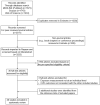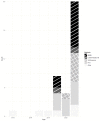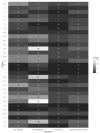Exposure to Metal Mixtures in Association with Cardiovascular Risk Factors and Outcomes: A Scoping Review
- PMID: 35324741
- PMCID: PMC8955637
- DOI: 10.3390/toxics10030116
Exposure to Metal Mixtures in Association with Cardiovascular Risk Factors and Outcomes: A Scoping Review
Abstract
Since the National Institute of Environmental Health Sciences (NIEHS) declared conducting combined exposure research as a priority area, literature on chemical mixtures has grown dramatically. However, a systematic evaluation of the current literature investigating the impacts of metal mixtures on cardiovascular disease (CVD) risk factors and outcomes has thus far not been performed. This scoping review aims to summarize published epidemiology literature on the cardiotoxicity of exposure to multiple metals. We performed systematic searches of MEDLINE (PubMed), Scopus, and Web of Science to identify peer-reviewed studies employing statistical mixture analysis methods to evaluate the impact of metal mixtures on CVD risk factors and outcomes among nonoccupationally exposed populations. The search was limited to papers published on or after 1998, when the first dedicated funding for mixtures research was granted by NIEHS, through 1 October 2021. Twenty-nine original research studies were identified for review. A notable increase in relevant mixtures publications was observed starting in 2019. The majority of eligible studies were conducted in the United States (n = 10) and China (n = 9). Sample sizes ranged from 127 to 10,818. Many of the included studies were cross-sectional in design. Four primary focus areas included: (i) blood pressure and/or diagnosis of hypertension (n = 15), (ii) risk of preeclampsia (n = 3), (iii) dyslipidemia and/or serum lipid markers (n = 5), and (iv) CVD outcomes, including stroke incidence or coronary heart disease (n = 8). The most frequently investigated metals included cadmium, lead, arsenic, and cobalt, which were typically measured in blood (n = 15). The most commonly utilized multipollutant analysis approaches were Bayesian kernel machine regression (BKMR), weighted quantile sum regression (WQSR), and principal component analysis (PCA). To our knowledge, this is the first scoping review to assess exposure to metal mixtures in relation to CVD risk factors and outcomes. Recommendations for future studies evaluating the associations of exposure to metal mixtures with risk of CVDs and related risk factors include extending environmental mixtures epidemiologic studies to populations with wider metals exposure ranges, including other CVD risk factors or outcomes outside hypertension or dyslipidemia, using repeated measurement of metals to detect windows of susceptibility, and further examining the impacts of potential effect modifiers and confounding factors, such as fish and seafood intake.
Keywords: blood pressure; cardiovascular diseases; dyslipidemia; hypertension; metal mixtures; preeclampsia.
Conflict of interest statement
The authors declare no conflict of interest.
Figures



Similar articles
-
Combined exposure to multiple metals on cardiovascular disease in NHANES under five statistical models.Environ Res. 2022 Dec;215(Pt 3):114435. doi: 10.1016/j.envres.2022.114435. Epub 2022 Sep 26. Environ Res. 2022. PMID: 36174761
-
Investigating the Interplay of Toxic Metals and Essential Elements in Cardiovascular Disease.J Xenobiot. 2025 May 9;15(3):68. doi: 10.3390/jox15030068. J Xenobiot. 2025. PMID: 40407532 Free PMC article.
-
Part 1. Statistical Learning Methods for the Effects of Multiple Air Pollution Constituents.Res Rep Health Eff Inst. 2015 Jun;(183 Pt 1-2):5-50. Res Rep Health Eff Inst. 2015. PMID: 26333238
-
Dietary glycation compounds - implications for human health.Crit Rev Toxicol. 2024 Sep;54(8):485-617. doi: 10.1080/10408444.2024.2362985. Epub 2024 Aug 16. Crit Rev Toxicol. 2024. PMID: 39150724
-
A State-of-the-Science Review on Metal Biomarkers.Curr Environ Health Rep. 2023 Sep;10(3):215-249. doi: 10.1007/s40572-023-00402-x. Epub 2023 Jun 20. Curr Environ Health Rep. 2023. PMID: 37337116 Free PMC article. Review.
Cited by
-
Assessing the combined effect of multiple metal exposures on pregnancy and birth outcomes: Methodological insights in systematic review research.MethodsX. 2024 Jan 6;12:102558. doi: 10.1016/j.mex.2024.102558. eCollection 2024 Jun. MethodsX. 2024. PMID: 38292318 Free PMC article. Review.
-
Individual, Independent, and Joint Associations of Toxic Metals and Manganese on Hypertensive Disorders of Pregnancy: Results from the MIREC Canadian Pregnancy Cohort.Environ Health Perspect. 2023 Apr;131(4):47014. doi: 10.1289/EHP10825. Epub 2023 Apr 20. Environ Health Perspect. 2023. PMID: 37079392 Free PMC article.
-
Toward a Mechanism-Driven Integrated Framework to Link Human Exposure to Multiple Toxic Metal(loid) Species with Environmental Diseases.Int J Mol Sci. 2024 Mar 16;25(6):3393. doi: 10.3390/ijms25063393. Int J Mol Sci. 2024. PMID: 38542366 Free PMC article. Review.
-
Single and Combined Associations of Plasma and Urine Essential Trace Elements (Zn, Cu, Se, and Mn) with Cardiovascular Risk Factors in a Mediterranean Population.Antioxidants (Basel). 2022 Oct 7;11(10):1991. doi: 10.3390/antiox11101991. Antioxidants (Basel). 2022. PMID: 36290714 Free PMC article.
-
Potential pathogenic roles of ferroptosis and cuproptosis in cadmium-induced or exacerbated cardiovascular complications in individuals with diabetes.Front Endocrinol (Lausanne). 2024 Oct 2;15:1461171. doi: 10.3389/fendo.2024.1461171. eCollection 2024. Front Endocrinol (Lausanne). 2024. PMID: 39415790 Free PMC article. Review.
References
-
- Cardiovascular Diseases. [(accessed on 9 September 2021)]. Available online: https://www.who.int/westernpacific/health-topics/cardiovascular-diseases.
-
- Chowdhury R., Ramond A., O’Keeffe L.M., Shahzad S., Kunutsor S.K., Muka T., Gregson J., Willeit P., Warnakula S., Khan H., et al. Environmental Toxic Metal Contaminants and Risk of Cardiovascular Disease: Systematic Review and Meta-Analysis. BMJ. 2018;362:k3310. doi: 10.1136/bmj.k3310. - DOI - PMC - PubMed
Publication types
Grants and funding
LinkOut - more resources
Full Text Sources

